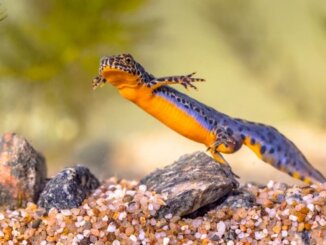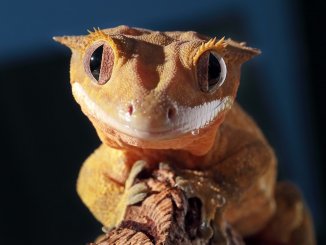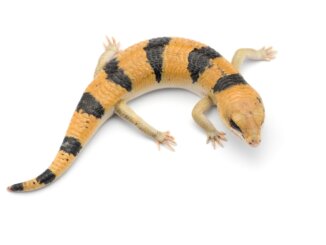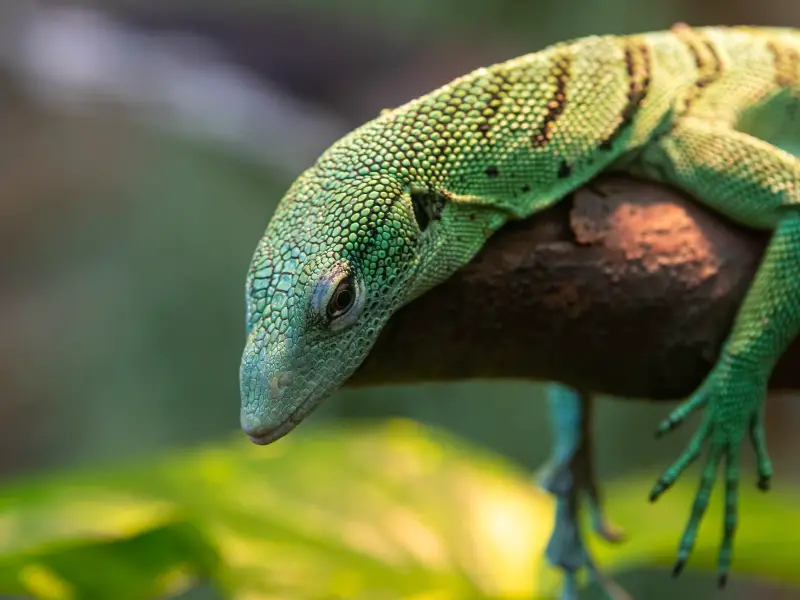
The green tree monitor, also known as the emerald tree monitor, is native to the islands of New Guinea and Indonesia. it’s an arboreal (tree-dwelling) lizard that uses its prehensile tail and long claws to climb from branch to branch quickly.
Gowing no longer than 3 feet, with a tail about twice the length of its body, the green tree monitor eats various insects, frogs, geckos, and small mammals. In captivity, collectors may even feed them cockroaches, crickets, and mice.
As an intelligent yet sensitive lizard, the green tree monitor requires a patient, understanding owner to tame. They can reach an old age of 15 years or more.
Green Tree Monitor Overview
| Common name | Green tree monitor, emerald tree monitor |
| Scientific name | Varanus prasinus |
| Natural habitat | Tropical evergreen jungles of New Guinea and Indonesia |
| Adult size | 2.5 to 3 feet with females typically smaller than males |
| Average lifespan | 10 - 15 years |
| Diet | Carnivore - mostly insects |
| Housing | Tall vivarium (minimum size: 36" x 18" x 36") |
| Experience | Intermediate to advanced |
Origin
The green tree monitor (Varanus prasinus) originated in Asia around 65 million years ago. They migrated down to Indonesia, New Guinea, and Australia.
Today, this monitor thrives in wet lowlands, tropical evergreen jungles, palm swamps, and plantations.
Unlike typical Varanids, this monitor doesn’t lash out with its tail when feeling threatened. Instead, it curls the tail up, trying to protect it.
These reptiles are listed as ‘least concern’ on the IUCN red list. Although the population estimate in the wild is not exactly known, numbers are considered stable.
Appearance And Behavior
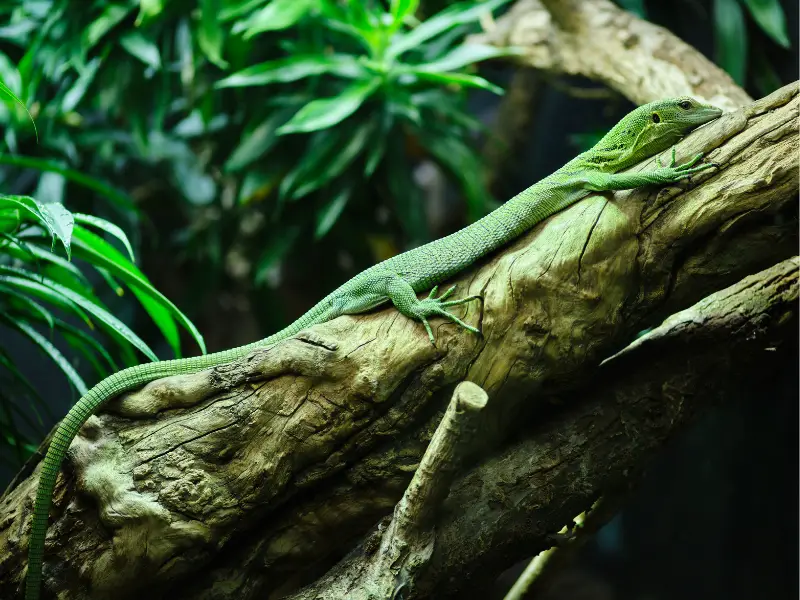
The Green Tree Monitor is a slender reptile with striking green and emerald colors. The colors may vary from green to turquoise. Some monitors sport dark, transverse dorsal colors.
These colors and their sensitive, intelligent nature make them popular pets for intermediate to experienced collectors.
The soles of their feet also have more oversized padding. This padding aids them in climbing trees and holding on to branches.
Size And Lifespan
The average adult green tree monitor is around 3 feet long. Typically, the tail is twice as long as the body.
In captivity, with the proper care, these monitors can reach an average age of 15 years. In the wild, interestingly, the average lifespan is unknown.
Like most Varanids, the male monitor is larger than its female counterpart.
Temperament
Green tree monitors tend to be quite sensitive. This delicate nature makes them difficult to keep in captivity. As such, beginners are advised to opt for a more robust species like the ridge-tailed monitor.
Unlike most monitors, the green tree monitor is a social reptile. It can comfortably live in small family groups with a dominant male, several females, and a few other males or juveniles.
If threatened, the green tree monitor will try to scurry away. It will only ever bite as a final resort.
Housing A Green Tree Monitor
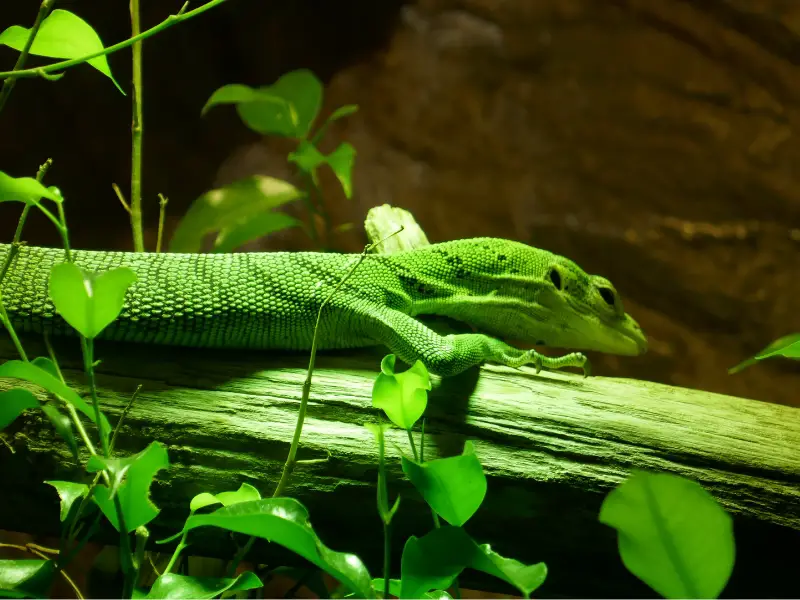
In the wild, these monitors live in wet swamps and jungles. And, as arboreal reptiles, they spend most of their time in trees, moving from branch to branch.
It’s best not to keep these reptiles in a screen enclosure, as this can make it challenging to regulate humidity. So, a large enclosure capable of maintaining moisture and heat is required if you want to keep one of these monitors as a pet.
Enclosure Size
An adult green tree monitor requires a large enclosure: at least 4 x 2 x 4 feet (48” x 24” x 48”). The minimum enclosure size for these reptiles is 36″ x 18″ x 36″.
If you wish to add another adult monitor, you must double the size of the enclosure. It’s best not to house these monitors together though as they are territorial.
Green tree monitors are agile climbers, so it’s essential to keep the top of the terrarium closed at all times. Keeping this closed will also help to regulate the temperature and humidity inside the enclosure.
Lighting
Like most monitors, this one requires a UVB light in its terrarium. UVB lights help monitors absorb calcium and synthesize vitamin D3.
Vitamin D3 is something that monitors naturally get from sunlight. Since your green tree monitor will live indoors, it’s vital to help them get vitamin D3 with a UVB light.
Try to find a bulb that can provide heat and UVB simultaneously. This significantly reduces the wiring needed and makes your enclosure more presentable.
Temperature And Humidity
Since green tree monitors originate from a tropical climate, they need a basking area inside the enclosure. The basking lamp should be joined with a thermostat to better regulate the temperature.
During the day, the temperature on the basking side of the enclosure should be between 95 and 100°F. At night, the temperature can drop to 78°F.
Place your heat elements on one side of the enclosure. This creates a temperature gradient. Your monitor will be able to self-regulate its temperature and move from the heated area to the cooler area as needed.
Don’t just use heat rocks on the hot side of the enclosure. The green tree monitor requires the entire basking area to be hot, not just a single spot.
To promote the feeling of a tropical environment, include a decently-sized bowl filled with water. Remember to regularly change the water, as it will get dirty.
Aim for a humidity of 80% inside the enclosure. Should the humidity drop below 80%, you only need to mist the enclosure a couple of times with a bottle or mister.
Failure to keep the enclosure at the correct humidity level will result in dehydration and potentially bad shedding.
Substrate And Decoration
When designing an enclosure for this monitor, remember that they are arboreal. So, focus on creating an exciting and engaging space for lots of climbing.
Leaf litter often works best as a substrate. It maintains humidity very well and encourages foraging and sifting behavior.
Construct several hides throughout the enclosure. This monitor is skittish and shy. Several areas to hide in will make it feel more comfortable and ensure it lives happily for many years.
When creating the hides, try adding some variety to them.
For instance, some hides should be cooler in temperature than others. Another hide can be smaller and hotter. This variety ensures that this active, intelligent monitor has several places to explore.
Cleaning
A quick spot clean every day will ensure your monitor enjoys a clean, sterile environment. It would help if you did a thorough, deep clean once a month.
Since this reptile can feel stressed out quickly, it’s best to keep it in a bio-active enclosure while cleaning the vivarium.
Replace the bedding, and spray a reptile-friendly disinfectant throughout the enclosure. Always try to do the cleaning during the day. Your monitor will appreciate the clean enclosure when you’re done.
Green Tree Monitor Care
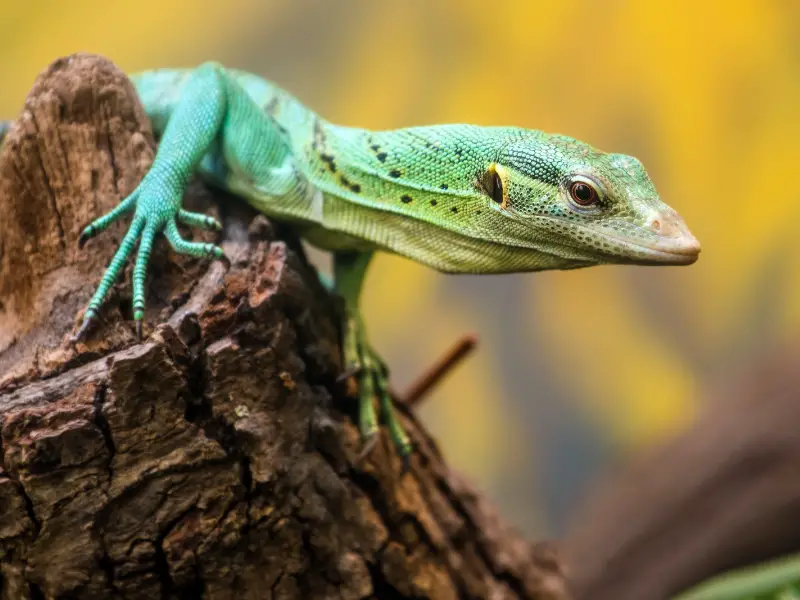
This monitor requires a handler with intermediate to advanced knowledge of monitors. These reptiles have a shy and fragile nature, making them prone to anxiety and stress.
Any stress can reduce the quality of life and lifespan of these monitors.
Food And Water
As arboreal monitors, these reptiles love eating tree-dwelling insects. They may also eat tiny frogs, mammals, and geckos.
The Smithsonian National Zoo feeds their monitors a steady diet of crickets, cockroaches, mice, and even mealworms.
You can feed your monitor once every other day. If you’re hand-rearing your monitor, it can quickly learn to eat canned crickets or cockroaches from a feeding tong.
These monitors need a constant supply of fresh, clean water. Make sure to clean this bowl out regularly, and change the water every day.
Handling
Avoid handling your monitors as much as possible. If mishandled, they will quickly become stressed.
To reduce handling stress, place the enclosure where your monitors can see you. This may be in your office, living room, or even kitchen.
Regularly feed your monitor, and clean its water bowl and enclosure.
Over time, the monitor will start to recognize you. Once your monitor gets used to you, it will stop running away from you. This will make handling less stressful.
Common Health Issues
Before buying one of these monitors, find out if a veterinarian near you has the knowledge to treat exotic reptiles.
Several common health problems may affect your monitor, and having a vet near you is a good idea.
Let’s cover some common health issues and how you can address them.
- Dehydration: Always ensure there’s a full bowl of clean water in the enclosure. Most of these monitors die from dehydration.
- Parasites: Regularly conduct fecal testing to ensure your monitor is parasite-free.
- Respiratory infections: These monitors can develop respiratory issues. Typically, they’ll be sluggish and won’t eat well. If that’s the case, seek out a vet as soon as possible.
Breeding
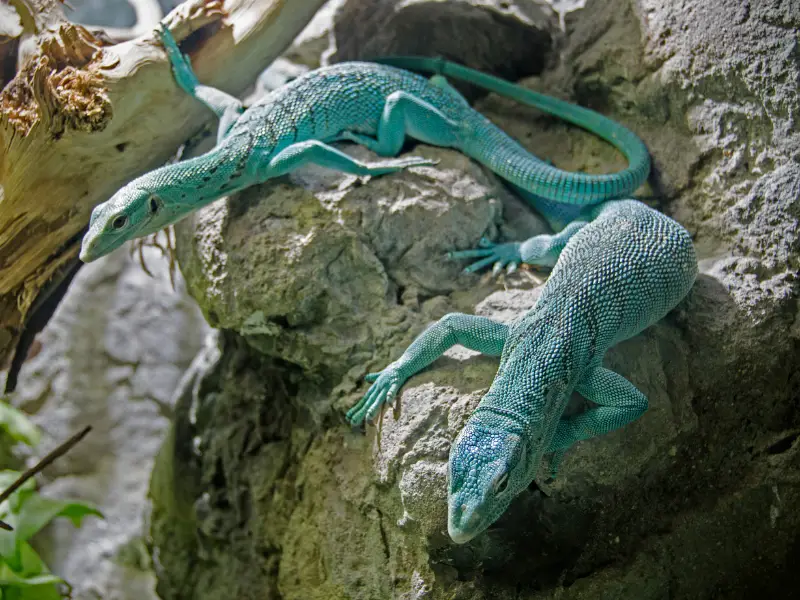
Breeding success with these reptiles is rare and inconsistent. Females go through reproductive cycles throughout the year. A female will only start a reproductive cycle when she’s in peak condition and when enclosure conditions are optimal.
Males will try to breed regardless of whether the female is in a reproductive cycle. The most successful breeding attempts occur when a single male and female share an enclosure.
Multiple males or females tend to complicate the social structure, which may cause fighting. Fighting, in turn, prevents the females from starting the reproductive cycle.
The female monitor can lay a clutch of up to 8 eggs. The eggs will take around 165 days to incubate. The young monitors grow extremely fast.
Choosing And Buying A Green Tree Monitor
These arboreal monitors are sensitive and shy.
It is not advised that first-time owners or inexperienced keepers buy these monitors. Check out this list of the top 10 mistakes beginners make to ensure you’re ready!
Despite their timid nature, these monitors have beautiful colors and are active and curious creatures. If you treat them correctly and provide the appropriate environment, they can be entertaining and rewarding to own.
If you’re a patient, caring handler, you can buy one of these monitors for anywhere between $700 to $1,200 from any exotic pet dealer or pet shop. They are not illegal, although make sure to check the specifics for your country.
If you’re considering one of these reptiles as your next pet, ensure that the one you choose is:
- Active and responsive.
- Vibrant in color and healthy-looking.
- Younger (younger monitors adapt better to new surroundings than older monitors).
Have fun creating the perfect enclosure, filled with vines, branches, and trees to simulate the natural habitat. If you look after your monitor well, you can expect it to live a long, happy life!

